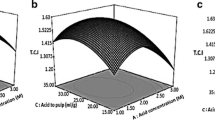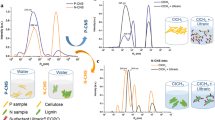Abstract
Caesalpinia sappan L. wood fiber (CSWF), a novel advanced bio-reinforcement for polybutylene succinate (PBS) composite films, has shown significant promise ranging from 0 to 15 part per hundred of resin (phr). The functional groups and interactions, morphology, thermal stability, mechanical characteristics, and biodegradability were all investigated. Without treatment or any compatibilizers, CSWF could be well-dispersed in the PBS matrix. The PBS/CSWF10 composite film had highest mechanical strength, with a tensile strength of 12.21 N/mm2 and a break elongation of 21.01%. Biodegradability studies indicated that the PBS/CSWF10 composite films degraded completely in three months. Furthermore, the Ea of degradation resulting from TGA and the shift of wavenumber resulting from FTIR revealed that the addition of CSWF has a greater interaction between additive and martix than conventional cellulose. The PBS/CSWF10 composite has the potential to be environmentally friendly, with promising short-term degradation and rising mechanical characteristics. Therefore, it is the optimum concentration of a certain biocomposite film. As a result, a novel advanced natural-based cellulose for biopolymer composites film was discovered, as well as other benefits for bio-reinforcement of the green plastic composite film industry.
Graphical abstract









Similar content being viewed by others
References
Bilal S, Gul S, Shah A-HA (2013) Calculation of activation energy of degradation of polyaniline-dodecylbenzene sulfonic acid salts via TGA
de Souza AG, de Lima GF, Colombo R, Rosa DS (2020) A new approach for the use of anionic surfactants: nanocellulose modification and development of biodegradable nanocomposites. Cellulose 27:5707–5728. https://doi.org/10.1007/s10570-020-03160-3
Gowman A, Wang T, Rodriguez-Uribe A et al (2018) Bio-poly(butylene succinate) and its composites with grape pomace: mechanical performance and thermal properties. ACS Omega 3:15205–15216. https://doi.org/10.1021/acsomega.8b01675
Grigoriadou I, Nianias N, Hoppe A et al (2014) Evaluation of silica-nanotubes and strontium hydroxyapatite nanorods as appropriate nanoadditives for poly(butylene succinate) biodegradable polyester for biomedical applications. Compos Part B Eng 60:49–59. https://doi.org/10.1016/j.compositesb.2013.12.015
Jost V (2018) Packaging related properties of commercially available biopolymers: an overview of the status quo. eXPRESS Polym Lett 12:429–435. https://doi.org/10.3144/expresspolymlett.2018.36
Kalogerakis N, Karkanorachaki K, Kalogerakis GC et al (2017) Microplastics generation: onset of fragmentation of polyethylene films in marine environment mesocosms. Front Mar Sci 4:84
Kim T, Jeon H, Jegal J et al (2018) Trans crystallization behavior and strong reinforcement effect of cellulose nanocrystals on reinforced poly(butylene succinate) nanocomposites. RSC Adv 8:15389–15398. https://doi.org/10.1039/C8RA01868E
Lee S-H, Wang S (2006) Biodegradable polymers/bamboo fiber biocomposite with bio-based coupling agent. Compos Part A Appl Sci Manuf 37:80–91. https://doi.org/10.1016/j.compositesa.2005.04.015
Lee JM, Mohd Ishak ZA, Mat Taib R et al (2013) Mechanical, thermal and water absorption properties of kenaf-fiber-based polypropylene and poly(butylene succinate) composites. J Polym Environ 21:293–302. https://doi.org/10.1007/s10924-012-0516-4
Liu L, Yuan Z, Fan X et al (2021) A review of interfacial bonding mechanism of bamboo fiber reinforced polymer composites. Cellulose. https://doi.org/10.1007/s10570-021-04242-6
Mochane MJ, Magagula SI, Sefadi JS, Mokhena TC (2021) A review on green composites based on natural fiber-reinforced polybutylene succinate (PBS). Polymers (basel). https://doi.org/10.3390/polym13081200
Mohamad N, Mazlan MM, Tawakkal ISMA et al (2021) Characterization of active polybutylene succinate films filled essential oils for food packaging application. J Polym Environ. https://doi.org/10.1007/s10924-021-02198-z
Mohammed AA, Bachtiar D, Rejab MRM, Siregar JP (2018) Effect of microwave treatment on tensile properties of sugar palm fibre reinforced thermoplastic polyurethane composites. Def Technol 14:287–290. https://doi.org/10.1016/j.dt.2018.05.008
Muthuraj R, Misra M, Mohanty AK (2015) Injection molded sustainable biocomposites from poly(butylene succinate) bioplastic and perennial grass. ACS Sustain Chem Eng 3:2767–2776. https://doi.org/10.1021/acssuschemeng.5b00646
Ngamwonglumlert L, Devahastin S, Chiewchan N, Raghavan GSV (2020) Color and molecular structure alterations of Brazilein extracted from Caesalpinia sappan L. under different pH and heating conditions. Sci Rep 10:12386. https://doi.org/10.1038/s41598-020-69189-3
Oliveira LFC, Edwards H, Velozo E, Nesbitt M (2002) Vibrational spectroscopic study of brazilin and brazilein, the main constituents of brazilwood from Brazil. Vib Spectrosc 28:243–249
Patil SS, Jena HM (2021) Performance assessment of polyvinyl chloride films plasticized with Citrullus lanatus seed oil based novel plasticizer. Polym Test 101:107271. https://doi.org/10.1016/j.polymertesting.2021.107271
Platnieks O, Gaidukovs S, Barkane A, et al (2020a) Bio-based poly(butylene succinate)/microcrystalline cellulose/nanofibrillated cellulose-based sustainable polymer composites: thermo-mechanical and biodegradation studies. Polymer 12
Platnieks O, Gaidukovs S, Barkane A, et al (2020b) Highly loaded cellulose/poly (butylene succinate) sustainable composites for woody-like. Adv Mater Appl Mol 25
Rafiqah SA, Khalina A, Harmaen AS et al (2021) A review on properties and application of bio-based poly(butylene succinate). Polymers (basel) 13:1436. https://doi.org/10.3390/polym13091436
Sukhawipat N, Raksanak W, Kalkornsurapranee E et al (2020a) A new hybrid waterborne polyurethane coating synthesized from natural rubber and rubber seed oil with grafted acrylate. Prog Org Coatings. https://doi.org/10.1016/j.porgcoat.2020.105554
Sukhawipat N, Saetung N, Pasetto P et al (2020b) A novel high adhesion cationic waterborne polyurethane for green coating applications. Prog Org Coatings 148:105854. https://doi.org/10.1016/j.porgcoat.2020.105854
Sundar N, Kumar SA, Keerthana P et al (2021) Schiff’s base (SB) modified zirconium dioxide reinforced PLA bio-composite film for industrial packaging applications. Compos Commun 25:100750. https://doi.org/10.1016/j.coco.2021.100750
Tarchoun AF, Trache D, Klapötke TM et al (2021) Chemical design and characterization of cellulosic derivatives containing high-nitrogen functional groups: Towards the next generation of energetic biopolymers. Def Technol. https://doi.org/10.1016/j.dt.2021.03.009
Tewtrakul S, Tungcharoen P, Sudsai T et al (2015) Antiinflammatory and wound healing effects of Caesalpinia sappan L. Phyther Res 29:850–856. https://doi.org/10.1002/ptr.5321
Xu H-X, Lee SF (2004) The antibacterial principle of Caesalpina sappan. Phyther Res 18:647–651. https://doi.org/10.1002/ptr.1524
Ye M, Xie W-D, Lei F et al (2006) Brazilein, an important immunosuppressive component from Caesalpinia sappan L. Int Immunopharmacol 6:426–432. https://doi.org/10.1016/j.intimp.2005.09.012
Zhang MQ, Rong MZ, Lu X (2005) Fully biodegradable natural fiber composites from renewable resources: All-plant fiber composites. Compos Sci Technol 65:2514–2525. https://doi.org/10.1016/j.compscitech.2005.06.018
Zhang K, Hamidian AH, Tubić A et al (2021) Understanding plastic degradation and microplastic formation in the environment: a review. Environ Pollut 274:116554. https://doi.org/10.1016/j.envpol.2021.116554
Zhou L, Ke K, Yang M-B, Yang W (2021) Recent progress on chemical modification of cellulose for high mechanical-performance Poly(lactic acid)/Cellulose composite: a review. Compos Commun 23:100548. https://doi.org/10.1016/j.coco.2020.100548
Acknowledgments
The authors would like to express our thanks to College of Industrial Technology, King Mongkut’s University of Technology North Bangkok for providing the facilities and Division of Physical Science, Department of Materials Science and Technology, Faculty of Science, Prince of Songkla University, Songkhla, Thailand. We would like to thanks to Dr. Yeampon Nakaramontri and Assoc. Prof. Dr. Nitinart Saetung for their kind suggestion. Moreover, we would like to thanks to Natthawadee Natsrita, Chaithip Kaewpang, Kittisak Kongsuk and Anutida Suwan for their helps.
Funding
None.
Author information
Authors and Affiliations
Contributions
Nathapong Sukhawipat: Conceptualization, Investigation, Writing – Original Draft, Writing—Review & Editing, Supervision, Visualization. Laksana Saengdee: Investigation. Pamela Pasetto: Writing—Review & Editing.
Corresponding author
Ethics declarations
Conflict of interest
All authors certify that they have no affiliations with or involvement in any organization or entity with any financial interest or non-financial interest in the subject matter or materials discussed in this manuscript.
Additional information
Publisher's Note
Springer Nature remains neutral with regard to jurisdictional claims in published maps and institutional affiliations.
Rights and permissions
About this article
Cite this article
Sukhawipat, N., Saengdee, L. & Pasetto, P. Caesalpinia sappan L. wood fiber: bio-reinforcement for polybutylene succinate-based biocomposite film. Cellulose 29, 3375–3387 (2022). https://doi.org/10.1007/s10570-022-04479-9
Received:
Accepted:
Published:
Issue Date:
DOI: https://doi.org/10.1007/s10570-022-04479-9




